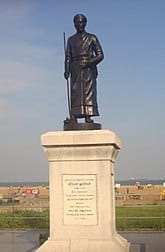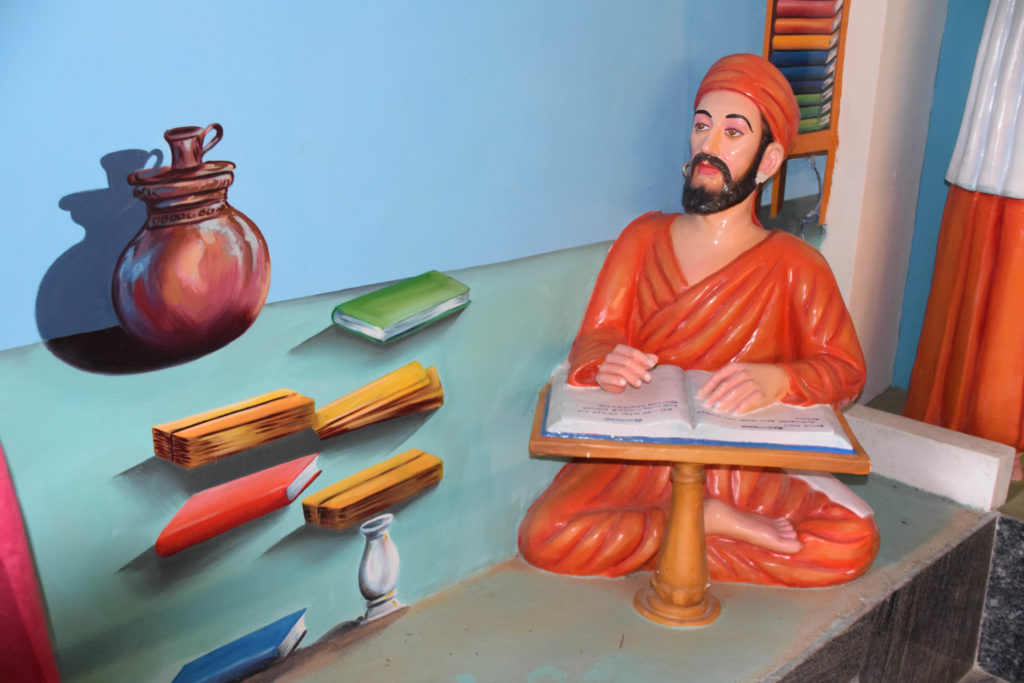BRIEF HISTORY OF THE SHRINE
PerianayagiAnnai Shrine was constructed by the great missionary Fr.Beshi. The place where the shrine is located was once a forest place. People used to come here for feeding their flocks. In the 17th century , the Italian Father and a great missionary, Fr.Beschi, brought two statues of Mother Mary to be kept in the place where he worked, namely Elakuruchi / Thirukavalur ( Now in Kumbakonam Diocese). He preached all over Tamil Nadu and on the way to his place he happened to pass over this forest and due to tiredness he slept under a tree with the two statues of Mother Mary. The boys, who were looking after the cattle, playfully hid one of the statues behind the bush. Fr.Beschi was shocked to know that one of the statues was missing and went to his place sadly.
THE SHRINE OF OUR LADY OF PERIYANAYAGI
There was a man called Kachirayar in MughasaParur had no child. Every day he used to pray to God. One day Mother Mary appeared to him in his dream and said ” Kachirayar, I’m alone in the forest if you build a chapel for me , I’ll give a child to you”. After saying this she disappeared. Hearing this he was very much happy and began to search for the statue in the forest. As they cut the bushes and trees, they found the statue behind a big bush. This statue is placed in the shrine till today. People constructed a small chapel and placed this statue there and began to worship.
After some time,Fr.Beshi happened to hear about this and came to Konankuppam and saw the small chapel built for the statue which he lost once. He was very much delighted and decided to make Konankuppam as his work place. He constructed the shrine which exists today. It is said to have been the first place of worship he erected and when it was completed he went to Madras and asked the Bishop of Mylapore to procure for him a statue from Manila, an image of the virgin, in native dress of Tamil Nadu and bearing the child Jesus in her arms, fashioned after a model he had made. The image eventually arrived and was set up in the church.
This life-size statue stands on a pedestal about ten feet high and is made of wood and painted in bright colours. In honour of it and of the Church, Fr.Beschi composed his Tamil Poem TEMBAVANI , which vying in length with the ILIAD itself is by far the most celebrated and most voluminous of his works. He completed this work in the year 1726. The Tamil conference conducted in Madurai during 1728 – 1729 AD approved his work and published it to imbibe the greatness of this literary work.
Fr. Costanzo Giuseppe Beschi (Veeramamunivar)
He was born at Castiglione in the Venetian Republic on 8th November, 1680; died on4th February. 1747.
Early years
Born in Castiglione delleStiviere, Beschi got his secondary education in the Jesuits’ High School at Mantua. After becoming a Jesuit in 1698, he was trained in Ravenna and Bologna from where he requested and obtained, from Superior General Michelangelo Tamburini, permission to be sent to the Jesuit mission at Madurai in South India. Sailing from Lisbon he reached Goa in October 1710, from where he proceeded immediately to South India. He arrived in Madurai in May 1711.
In South India
Inspired by what was done in China, Beschi adopted the native Tamilians’ lifestyle in his life and in his missionary work. For example, he adopted the saffron coloured robe generally worn by a sannyasi (Indian ascetic). He visited several important centres such as Tirunelveli, Ramanathapuram, Thanjavur and, of course, Madurai to learn the Tamil language. He met with persecution in 1714–15 and escaped a death sentence. This gave him more time to master the Tamil language in which he soon showed great proficiency.
During the first six years, he worked as a missionary in Elakurichy, a town near Tiruvaiyaru. Then he served as parish priest in Kamanayakkanpatti, one of the oldest mission centres in Tamil Nadu. He worked in the Thanjavur area till 1738 and settled in 1740 on the Coromandel Coast where he remained till the end of his life.
He helped build the PoondiMatha Basilica at Poondi near Thanjavur, VyagulaMatha Church at Thanjavur, The PerianayagiAnnai Shrine, Konankuppam at Mugasaparur in Konankuppam, and AdaikalaMaadha Shrine at Elakurichi.These churches are now Catholic pilgrim centres.
He died at Ambalakaadu in Thrissur, Kingdom of Cochin (now a part of the state of Kerala), and is buried at Sampaloor, where his tomb can be seen.
Contribution to Tamil literature
No sooner had he arrived in India than he began the study of Sanskrit, Telugu, and especially of Tamil. Thanks to his genius and indefatigable industry, he mastered the Tamil grammar in five years, and for the next twenty years made so thorough a study of the whole field of Tamil literature that the native men of letters bowed to him as their master.
Constantine compiled the first Tamil lexicon – a Tamil-Latin dictionary. He also compiled the comprehensive Chaturakarati(சதுரகராதி), a quadruple lexicon containing words, synonyms, and categories of words and rhymes.
He translated and explained in Latin the “Thirukkural”, an epic poem of Thiruvalluvar. This Latin work was an eye opener for European intellectuals, enabling them to discover truth and beauty in Tamil literature. He also translated into European languages several other important Tamil literary works such as Devaaram(தேவாரம்), Thiruppugazh (திருப்புகழ்),Nannool (நன்னூல்)andAaththichoodi(ஆத்திசூடி).
Besides composing literary Tamil Grammar work, he also wrote a grammar for the common use of Tamil (Urainadaiillakkiyam – உரை நடைஇலக்கியம்), which at times led to him being referred to as the ‘Father of Tamil Prose’.
Earlier Tamil scripts were written without the tittle (புள்ளி) for consonants, and the symbol ரwas used to indicate long vowels. It was Veeramamunivar who introduced the system of dotting the Tamil consonants (க், ங், ச், … )and writing the long vowels as ஆinstead of அர, கா instead of கர, etc.
His biggest poetical work is the Thembavani(தேம்பாவணி – The Unfading Garland – an ornament of poems as sweet as honey), 3615 stanzas long on salvation history and the life of Saint Joseph.
This Tamil “DivinaComedia” is divided into thirty-six cantos, containing 3,615 stanzas. “It is,” says Baumgartner, “the noblest epic poem in honor of St. Joseph written in any literature, East or West. In one of the most difficult languages of southern India Beschi produced a poem which for richness and beauty of language, for elegance of meter, popular treatment, and true poetical conception and execution, is the peer of the native classics; in nobility of thought and subject-matter, it is as superior to them as the harmonious civilization of Christianity rises above the confused philosophical dreams and ridiculous fables of idolatry.”
He also wrote a prabandham (a minor literature) called KaavalurKalambagam (காவலூர் கலம்பகம்), a grammatical treatise called Thonnool(தொன்னூல்), a guide book for catechists with the title VedhiyarOzukkam(வேதியர் ஒழுக்கம்), and ParamarthaguruvinKadhai (பரமார்த்தகுருவின் கதை – The Adventures of Guru Paramartha), a satirical piece on a naive religious teacher and his equally obtuse disciples. In a poem of 1100 stanzas, “Kittêriammallesaritiram” he sings the praises of the martyr St. Quiteria (not St. Catherine, as some writers have mistakenly asserted).
His prose works include didactic religious books for the instruction of Catholics.
Recognition by Tamil Nadu State:
Veeramamunivar statue at the Marina Beach, Chennai in Tamil Nadu state

In 1968, the State of Tamil Nadu erected a statue for Beschi on the Marina beach in the city of Chennai as a recognition for his contribution to Tamil language and literature.
Courtesy: Catholic Encyclopaedia and Wikipedia
Inculturation
Inspired by what was done in China, Beschi adopted an Indian life style and introduced elements of Indian aesthetics even in the Christian statuary. He made himself a sannyasi (Indian ascetic) and adopted their saffron coloured robe.
Periyanayagi Statue:
The first church he erected, was at KonankuppamAryanoor, inParur, which then belonged to MootoosamyCachirayen, a chieftain. After its completion, Father Beschi proceeded to Mylapore, and solicited the then bishop of that diocese, to procure for him, from Manilla, an image of the Blessed Virgin Mary, in the native dress, with the child Jesus in her arms, according to a model he had drawn for that purpose. The prelate complied with his request, and on its arrival, he performed a devotion of 11 days; and, on the 13th, placed the image in the church which was dedicated to God in the name of Mother Mary Periyanayagi.

